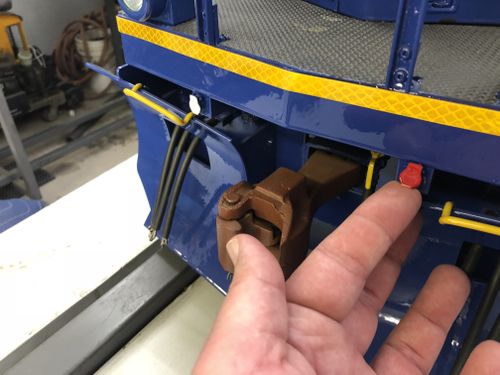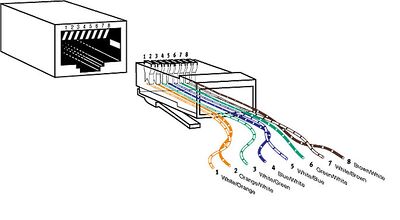Multi-unit lashup: Difference between revisions
Jump to navigation
Jump to search
| Line 30: | Line 30: | ||
<i>Editor: Please note the pinout below is modified from Mr. Gonthier's initial description.</i> | <i>Editor: Please note the pinout below is modified from Mr. Gonthier's initial description.</i> | ||
=== Description === | |||
* Two [[Multi-unit lashup]] cables are defined. Pinout #1 is required, Pinout #2 is optional. | |||
* All signals range from 0 volts D.C. (ground) to 12 volts D.C. | |||
* The signals use "positive logic" (e.g. 12 volts D.C. indicates the signal is active) | |||
* Every signal is carried through the locomotive from front to back and, unless otherwise noted, are not modified by the locomotive | |||
* Signal voltages may need to be converted to different logic levels on each locomotive | |||
* Up to four units (locomotives) may be joined together without further signal amplification | |||
* The source generating each signal must supply a minimum of 100 milliamps for 0 and 12 volts D.C. | |||
* Each unit (locomotive) must consume no more than 20 milliamps from a given signal | |||
=== Pinout #1 === | === Pinout #1 === | ||
[[File:MU Pinout using RJ-45 Connector.jpg|thumb|right|400px|Pinout mapping for RJ-45 Socket and Plug]] | [[File:MU Pinout using RJ-45 Connector.jpg|thumb|right|400px|Pinout mapping for RJ-45 Socket and Plug]] | ||
:* Pin 1. 12V (Signal high) - white/orange | :* Pin 1. 12V (Signal high) - white/orange | ||
| Line 46: | Line 56: | ||
=== Pinout #2 === | === Pinout #2 === | ||
:* Pin 1. 12V (Signal high) | :* Pin 1. 12V (Signal high) - white/orange | ||
:* Pin 2. Headlight High Beam | :* Pin 2. Headlight High Beam - orange/white | ||
:* Pin 3. Headlight Low Beam | :* Pin 3. Headlight Low Beam - white/green | ||
:* Pin 4. Ground (Signal Low) | :* Pin 4. Ground (Signal Low) - blue/white | ||
:* Pin 5. Bell | :* Pin 5. Bell - white/blue | ||
:* Pin 6. Compressor | :* Pin 6. Air Compressor - green/white | ||
:* Pin 7. Number Board Lights | :* Pin 7. Number Board Lights - white/brown | ||
:* Pin 8. Step Lights | :* Pin 8. Step Lights - brown/white | ||
Revision as of 17:15, 30 December 2021
Model Connectors
External Links
- "Multi-unit train control", Wikipedia
- "MU Lashup Wiring Standard", Chaski.org
- "Riding railkits mu cable", Chaski.org
- "US Loco MU Control"
- "How One Engineer Operates Several Diesels" (PDF)
- "Operation and Maintenance of Diesel-Electric Locomotives", US Army
- "Locomotive Command and Control Module (LCCM) - Functional Requirements", AAR
Proposed Standard
Aaron Gonthier wrote 22 August 2019:
- I am working on a standard for locomotive control wiring for battery electric locomotives. It uses a premade Ethernet cable to go from the motor controller (or other control device) to the handheld throttle. The purpose of the standard is to make it easy to change out a broken cable or swap handheld throttles, cables and controllers from one locomotive to another with a minimum amount of rewiring. Ethernet cables are available most places in North America, from big box stores to convenience stores. They work with analog or digital control systems and allow for basic controls and a minimal amount of electronics in the handheld throttle.
- Having only the essential controls simplifies wiring, with only throttle, forward/reverse, horn and optional brake controls. Lighting controls can be on the locomotive or integrated with the reverser controls using a relay on the locomotive.
- My hope with this proposed standard is to make it a little easier for people building and maintaining battery electric locomotives. Your input is appreciated.
- Aaron Gonthier
- Mill Brook Railroad
- Windsor, VT
Editor: Please note the pinout below is modified from Mr. Gonthier's initial description.
Description
- Two Multi-unit lashup cables are defined. Pinout #1 is required, Pinout #2 is optional.
- All signals range from 0 volts D.C. (ground) to 12 volts D.C.
- The signals use "positive logic" (e.g. 12 volts D.C. indicates the signal is active)
- Every signal is carried through the locomotive from front to back and, unless otherwise noted, are not modified by the locomotive
- Signal voltages may need to be converted to different logic levels on each locomotive
- Up to four units (locomotives) may be joined together without further signal amplification
- The source generating each signal must supply a minimum of 100 milliamps for 0 and 12 volts D.C.
- Each unit (locomotive) must consume no more than 20 milliamps from a given signal
Pinout #1
- Pin 1. 12V (Signal high) - white/orange
- Pin 2. Train Brake Release (optional) - orange/white
- Pin 3. Forward - white/green
- Pin 4. Ground (Signal Low) - blue/white
- Pin 5. Horn - white/blue
- Pin 6. Reverse - green/white
- Pin 7. Train Brake Apply (optional) - white/brown
- Pin 8. Speed - brown/white
Pinout #2
- Pin 1. 12V (Signal high) - white/orange
- Pin 2. Headlight High Beam - orange/white
- Pin 3. Headlight Low Beam - white/green
- Pin 4. Ground (Signal Low) - blue/white
- Pin 5. Bell - white/blue
- Pin 6. Air Compressor - green/white
- Pin 7. Number Board Lights - white/brown
- Pin 8. Step Lights - brown/white

